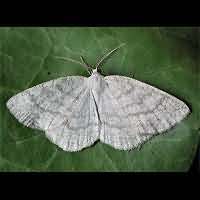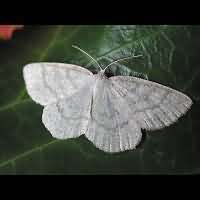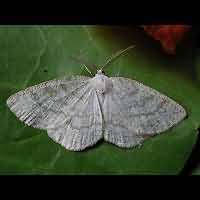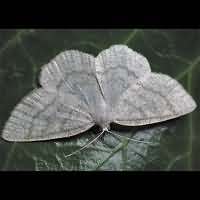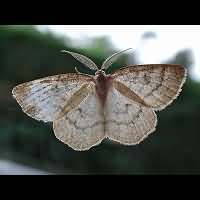Common Wave (Cabera exanthemata)
The Common Wave is one of a group of whitish geometers showing some darker bands, waves, smears of dots. In his case there are three grey lines over the wings. The upper two may be hardly visible at times, but the last one is always there, even in very worn out animals. It is very similar to the Common White Wave. Yet you can tell them apart by examining the lines, especially the last one. In the Common Wave the line runs slightly rounded and there is an obvious bend in the middle. In the Common White Wave the line runs straight from side to side with no visible bends. Another similar species is the Cream Wave, but it usually has more than 3 visible lines, which are more edged and not wavy. It also has black dots in the middle of the hind wings. The Common Wave isn't very variable in size, for the wingspan is some 32 to 35 mm.
The caterpillars are usually seen from June to autumn. They are lightgreen (even though sometimes brown) and rather narrow. On the back is a dark green dorsal line, accompanied on both sides by a whitish green line. Often there are dark to black dots at the end of each segment. The head is dark green at first, then turns lighter. They'll reach a length of some 27 to 30 mm. In autumn the larvae of the Common Wave go the the ground in which they pupate shoulkd the soil be light and dry. Otherwise they pupate between plant debris. The pupa overwinters. Even though the caterpillars are found on a number of trees, they prefer willow, sallow and aspen.
The Common Wave produces two generations in Southern England and one in Scotland, but is on the wing for a long time in both cases: from mid-May to the end of Augustus. Easy to spot flying about, for it becomes active in early dusk. Is attracted to light, but in very small numbers only. A common, sometimes even abundant species all over the British Isles. And just as common on the continent.
The Common Wave is one of a group of whitish geometers showing some darker bands, waves, smears of dots. In his case there are three grey lines over the wings. The upper two may be hardly visible at times, but the last one is always there, even in very worn out animals. It is very similar to the Common White Wave. Yet you can tell them apart by examining the lines, especially the last one. In the Common Wave the line runs slightly rounded and there is an obvious bend in the middle. In the Common White Wave the line runs straight from side to side with no visible bends. Another similar species is the Cream Wave, but it usually has more than 3 visible lines, which are more edged and not wavy. It also has black dots in the middle of the hind wings. The Common Wave isn't very variable in size, for the wingspan is some 32 to 35 mm.
The caterpillars are usually seen from June to autumn. They are lightgreen (even though sometimes brown) and rather narrow. On the back is a dark green dorsal line, accompanied on both sides by a whitish green line. Often there are dark to black dots at the end of each segment. The head is dark green at first, then turns lighter. They'll reach a length of some 27 to 30 mm. In autumn the larvae of the Common Wave go the the ground in which they pupate shoulkd the soil be light and dry. Otherwise they pupate between plant debris. The pupa overwinters. Even though the caterpillars are found on a number of trees, they prefer willow, sallow and aspen.
The Common Wave produces two generations in Southern England and one in Scotland, but is on the wing for a long time in both cases: from mid-May to the end of Augustus. Easy to spot flying about, for it becomes active in early dusk. Is attracted to light, but in very small numbers only. A common, sometimes even abundant species all over the British Isles. And just as common on the continent.

